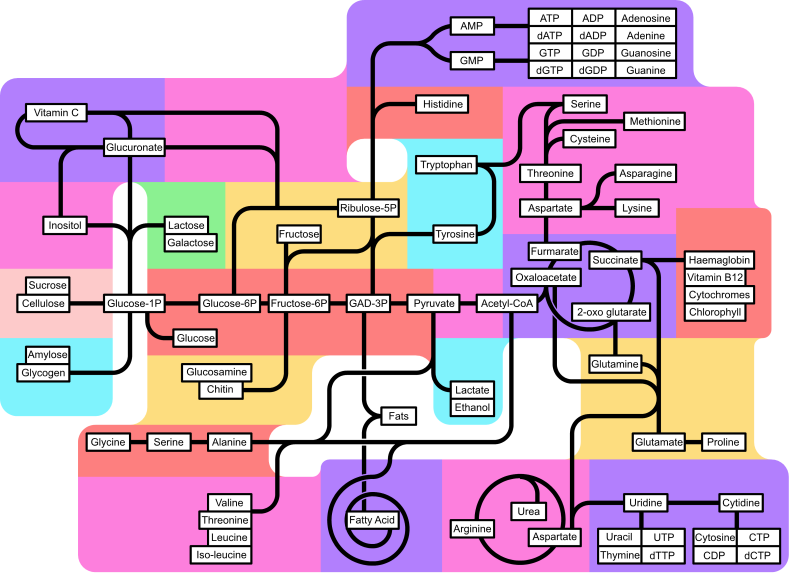Metabolic pathway
From Wikipedia, the free encyclopedia
In biochemistry, a metabolic pathway is a series of chemical reactions occurring within a cell. In each pathway, a principal chemical is modified by chemical reactions. Enzymes catalyze these reactions, and often require dietary minerals, vitamins, and other cofactors in order to function properly. Because of the many chemicals that may be involved, pathways can be quite elaborate. In addition, many pathways can exist within a cell. This collection of pathways is called the metabolic network. Pathways are important to the maintenance of homeostasis within an organism.
Metabolism is a step-by-step modification of the initial molecule to shape it into another product. The result can be used in one of three ways:
- To be stored by the cell
- To be used immediately, as a metabolic product
- To initiate another metabolic pathway, called a flux generating step.
A molecule called a substrate enters a metabolic pathway depending on the needs of the cell and the availability of the substrate. An increase in concentration of anabolic and catabolic end-products would slow the metabolic rate for that particular pathway.
Contents |
[edit] Overview
Each metabolic pathway is composed of a series of biochemical reactions that are connected by their intermediates: The reactants (or substrates) of one reaction are the products of the previous one, and so on. Metabolic pathways are usually considered in one direction (although all reactions are chemically reversible, conditions in the cell are such that it is thermodynamically more favorable for flux to be in one of the directions).
-
- Glycolysis was the first metabolic pathway discovered:
- As glucose enters a cell, it is immediately phosphorylated by ATP to glucose 6-phosphate in the irreversible first step. This is to prevent the glucose from leaving the cell.
- In times of excess lipid or protein energy sources, glycolysis may run in reverse (gluconeogenesis) in order to produce glucose 6-phosphate for storage as glycogen or starch.
- Metabolic pathways are often regulated by feedback inhibition, or by a cycle wherein one of the products in the cycle starts the reaction again, such as the Krebs Cycle (see below).
- Anabolic and catabolic pathways in eukaryotes are separated either by compartmentation or by the use of different enzymes and cofactors.
[edit] Major metabolic pathways
[edit] Cellular respiration
Several distinct but linked metabolic pathways are used by cells to transfer the energy released by breakdown of fuel molecules to ATP. These occur within all living organisms in some forms:
Other pathways occurring in (most or) all living organisms include:
- Fatty acid oxidation (β-oxidation)
- Gluconeogenesis
- HMG-CoA reductase pathway (isoprene prenylation chains, see cholesterol)
- Pentose phosphate pathway (hexose monophosphate shunt)
- Porphyrin synthesis (or heme synthesis) pathway
- Urea cycle
Creation of energetic compounds from non-living matter:
- Photosynthesis (plants, algae, cyanobacteria)
- Chemosynthesis (some bacteria)
[edit] See also
[edit] External links
- BioCyc: Metabolic network models for hundreds of organisms
- KEGG: Kyoto Encyclopedia of Genes and Genomes
- MetaCyc: A database of nonredundant, experimentally elucidated metabolic pathways (900+ pathways from more than 800 different organisms).
- Metabolism, Cellular Respiration and Photosynthesis - The Virtual Library of Biochemistry and Cell Biology
- PathCase Pathways Database System
- Interactive Flow Chart of the Major Metabolic Pathways
- A novel visualization for a Metabolic Pathway
- DAVID: Visualize genes on pathway maps
- Wikipathways: pathways for the people
- ConsensusPathDB
|
|||||||||||||||||||||||||||


